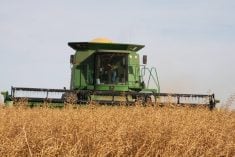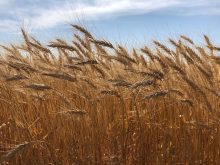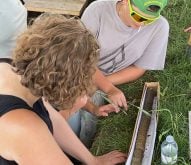Mint is a hardy perennial plant known for its ability to survive harsh winters like those found in Western Canada, but you won’t find many places in the Prairies where it is grown as a commercial crop.
Quattro Ventures in Alberta is one of very few. Emily Ford, senior agronomist at the joint-venture farm where mint is cultivated for the essential oils market, knows of only one other Prairie farm producing this specialty crop.
Read Also

Claas brings 1000 Series SP forage harvesters to Canada
In mid-August, Claas unveiled its new line of Jaguar forage harvesters at an event in Visalia, California, deep in the heart of that state’s dairy region.
Ford said this presents some unique challenges for agronomists like herself.
“When you are growing other specialty crops, let’s say potatoes in southern Alberta for example, you usually have a wealth of peers and experts to phone up when something looks funny or you have a problem,” Ford said.
Why it matters: If a given crop isn’t often commercially grown on the Prairies, that doesn’t necessarily mean it was never possible.
With mint, there isn’t a network of people Ford can readily turn to for help. She noted some agronomic information is available through organizations, such as the Mint Industry Research Council in the United States, but much of what Ford understands about commercial mint production has been largely self-taught.
“I didn’t know anything about mint five years ago until I started working at Quattro,” Ford said, adding trial and error has been an important aspect of the learning process.
“If you are given the opportunity to work with a crop like this, you just dive in, read as much as you can, lean on the people who know something about it, and don’t be afraid to make mistakes. You have to work with farmers to figure it out together, because mint is so different from other crops that are really commonly grown,” she said.
“I think agronomists become agronomists because we’re curious people who want to find out how things work, so I can say this has been a fun challenge.”

Community curiosity around this novel crop has been strong as well. Ford noted a lot of producers in the area have visited Quattro Ventures so they could get a first-hand look at commercial mint production.
“We do a lot of farm tours, but so far no one has taken the plunge and tried it.”
Located in the Bow Island/Burdett area in southeastern Alberta, Quattro Ventures comprises five family farms cultivating a diverse array of crops across dryland and irrigated acres. This includes dill, another speciality crop grown for the essential oils market, as well as cereals, seed canola, peas and potatoes.
Ford helps run the 3,000-acre operation as part of the farm’s management team, which includes both owners and non-owners. Quattro Ventures was founded by the Palliser Triangle Marketing Group, a collection of forward-thinking farmers intent on exploring new agricultural marketing opportunities. The idea behind it was to unite the strengths of individual family farms while leveraging the group’s collective knowledge, resources and markets.
Essential oils are highly concentrated, aromatic liquids extracted from plants that capture the plant’s fragrance and flavour. The spearmint and peppermint essential oils produced by Quattro Ventures go into such things as candy, chewing gum, toothpaste and cosmetics, while the farm’s dill essential oil is used for dill pickles.
According to Ford, India and the U.S. Pacific Northwest are the main areas that produce mint for the essential oils market. In Ford’s estimation, Quattro Ventures has grown to the point where it now produces 25 per cent of North America’s mint oil.
One reason more Prairie farms haven’t followed Quattro Ventures’ lead could be that commercial mint production isn’t for the faint of heart.

Mint is a perennial rhizome crop that propagates through rhizome cuttings, not seed, so specialized agricultural machinery is required for planting and harvesting. Specialized processing equipment is also needed to extract and distill the oil from the harvested mint leaves.
Ford acknowledged some farmers may shy away from the risks associated with producing an unfamiliar crop such as mint, given the hefty expense of getting everything up and running.
“It’s a big investment. You need to have specialized equipment and facilities to process the oil and get it to market, and it’s very expensive.”
Area well-suited for mint
According to Ford, Quattro Ventures’s location in southeastern Alberta has several attributes that make it a prime area for producing high-quality mint oil.
One is linked to where it is situated in the Canadian brown soil zone. “Because of the soil types we have here, we produce a certain oil that meets quality standards the flavour houses or brokers are looking for with purity, menthol content, aroma, all of those sorts of things.”
Growing conditions in the area are another major plus. Mint requires long, warm summer days and cooler nights for optimal oil production. Quattro Ventures fits the bill, with an extended growing window of 124 to 132 frost-free days and average crop heat units in the 2,400 range.
As well, mint is a thirsty crop requiring reliable, consistent moisture, especially during peak summer heat. Quattro Ventures relies heavily on irrigation infrastructure provided by the St. Mary River system — something that’s particularly important within the drought-prone Palliser Triangle region where the farm is located.
“You can’t grow mint without irrigation,” Ford said. “At peak crop staging with the hot, dry weather, you’re looking at an inch to an inch and a half of water a week.”

Planting and field management
Each mint production cycle at Quattro Ventures starts with disease-free tissue culture plantlets the farm gets from a specialty nursery. The plantlets aren’t planted in fields right away but are placed in nursery blocks where they serve as a source of clean rhizome rootstock.
“Once those plantlets are established, the next spring we go back and dig up some of the rhizomes from that clean stock. We use a modified potato digger to dig up them up and then they’re planted into a production field.
“You only need one inch of a viable rhizome to create a mint plant. The first year we really focus on establishment and then after that, we’re looking at production and are harvesting a crop every year.”
The mint fields, once established, will remain productive for up to five years, Ford said, adding “because it is a five-year crop, there is no tillage on that piece of land for five years.” She noted this kind of tillage reprieve provides a nice break for fields, particularly since Quattro Ventures grows some heavier tillage crops, such as sugar beets and potatoes.
“I think that’s really beneficial for soil health, not just for the mint crop but for all the other subsequent crops we grow on that land.”
According to Ford, mint is a heavy feeding crop for fertilizer, which is applied to Quattro Ventures mint fields in the spring. Typically, each acre receives 120 to 150 pounds of nitrogen, along with 100 pounds of potassium and 80 pounds of phosphorus. Because mint doesn’t grow in rows, fertilizer is distributed through broadcast applications.
In recent years, Quattro Ventures has started using environmentally smart nitrogen products for its nitrogen applications in mint fields. Ford said the slow-release fertilizer allows nutrient availability to be better matched with crop uptake. It has also meant fertigation, something the farm has practiced in the past, is no longer needed.
The mint at Quattro Ventures is typically harvested in late July to early August. Swathed crops are chopped with forage harvesters and loaded into specialized tubs, which connect directly to steam lines at a central distillation facility at the farm where the essential oils are extracted.
Crop residues left over from the distilling process serve a very useful purpose, Ford said. They spread the “mint plugs” on the fields to increase organic matter and remediate areas that are erosion-prone.
“It is a nice soil addition, with very similar characteristics to well-composted cattle manure. And there aren’t any restrictions on what fields you can put it on because it’s clean. It has been steamed to 300 degrees, so essentially all the weed seeds are not viable.”
Weed, disease and pest management
According to Ford, weed control in mint is critical, especially after it is first planted in a production field.
She noted because mint is a broadleaf crop, there are limited options for broadleaf weed control. As a result, Ford said, “we really focus on the first couple of years trying to get weed free. Usually by the fifth year, it’s a tough time to try to control those broadleaf weeds.”
Careful herbicide selection is also essential because of rotational considerations for the following crops. “Re-cropping restrictions mean there are only certain chemicals we can apply in the first couple of years of a mint stand.”
As far as disease threats go, powdery mildew is an important one to watch for in mint because it is a heavy canopy crop. Powdery mildew is a fungal infection that can cause mint leaves to wilt and fall off.
“It is imperative to maintain those leaves, because the leaves are where the oil is. You don’t want them on the ground,” Ford said, adding early fungicide applications are used as a preventative measure at Quattro Ventures to help protect against powdery mildew.
Ford noted verticillium wilt is also on the farm’s radar since it has been a problem for mint producers elsewhere, particularly in areas when mint has been cultivated for much longer than it has in southeastern Alberta.
“We have been lucky not to see it here. That’s something you have to really watch out for, because there’s nothing to be done about verticillium wilt once it shows up.”
According to Ford, disease control efforts are hampered due to very few products with minor use registration being available for a specialty crop such as mint. It’s a big reason Quattro Ventures always ensures it is sourcing disease-free mint stock.
Ford said while mint is generally resistant to major insect pressure, spider mites can emerge during hot, dry spells. They can harm mint plants by sucking the oil out of the leaves.
However, spider mites usually only appear near the field edges, Ford noted, adding the bugs avoid moisture so they can be effectively controlled with irrigation.
















